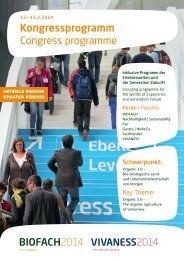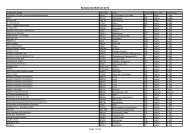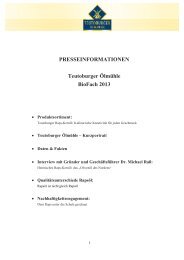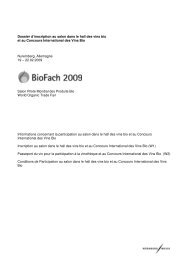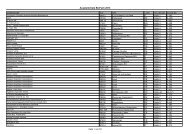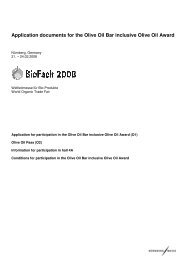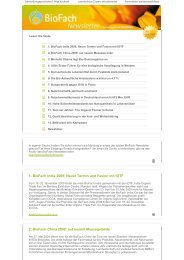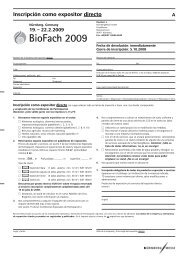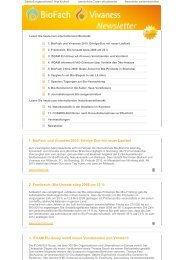Instruction Sheet âSuspension points, trusses and lifting ... - Powtech
Instruction Sheet âSuspension points, trusses and lifting ... - Powtech
Instruction Sheet âSuspension points, trusses and lifting ... - Powtech
Create successful ePaper yourself
Turn your PDF publications into a flip-book with our unique Google optimized e-Paper software.
<strong>Instruction</strong> <strong>Sheet</strong><br />
“Suspension <strong>points</strong>, <strong>trusses</strong> <strong>and</strong> <strong>lifting</strong> equipment”<br />
255<br />
i4.9<br />
The suspension of objects from the hall ceiling, the provision of suspension<br />
<strong>points</strong> <strong>and</strong> the modification of suspension constructions are carried out<br />
exclusively by NürnbergMesse through its appointed ServicePartners.<br />
Suspension <strong>points</strong> must be ordered in writing from the Exhibition Services<br />
Dept. of NürnbergMesse using Form S2.15. The construction to be suspended<br />
must be located within the st<strong>and</strong> boundaries. The maximum vertical<br />
structural load capacity of each suspension point on the ceiling construction<br />
is 25 kg for halls 1, 2, 3, 4, 5, 6, 7, 8, 9, 10 <strong>and</strong> 12. Higher loads are only<br />
possible on request via the Facility & Event Services department <strong>and</strong> after<br />
a structural inspection by an engineer appointed by NurnbergMesse.<br />
The exhibitor or client will be charged for the cost of such a structural<br />
inspection.<br />
The following types of suspension are not permitted<br />
for safety reasons:<br />
Suspended constructions with a rigid or non-positive connection to the<br />
hall floor (see Figure 1 <strong>and</strong> 2)<br />
Suspension <strong>points</strong> used for securing st<strong>and</strong> components or exhibits<br />
(st<strong>and</strong> components or exhibits must st<strong>and</strong> securely on their own, see<br />
Figure 3 <strong>and</strong> 4)<br />
Suspension from exhibits (see Figure 5 <strong>and</strong> 6)<br />
The use of bridle suspension <strong>points</strong> is not permitted on the<br />
NürnbergMesse site (see Figure 7)<br />
Abbildung Figure 1 1 Abbildung Figure 2 2<br />
Abbildung Figure 3 3<br />
Abbildung Figure 4 4<br />
Impermissible Unzulässig<br />
Permissible Zulässig<br />
Impermissible Unzulässig<br />
Permissible Zulässig<br />
Abbildung Figure 5 5 Abbildung Figure 6 6<br />
Abbildung Figure 7 7<br />
Abbildung Figure 8 8<br />
Bridle<br />
Exhibit<br />
Exhibit<br />
Impermissible Unzulässig<br />
Permissible Zulässig<br />
Impermissible Unzulässig<br />
Permissible Zulässig<br />
The use of <strong>lifting</strong> equipment (electric chain hoists, manual chain hoists,<br />
sling hoists) is only possible in halls 4A, 7A, 11 <strong>and</strong> NCC Ost <strong>and</strong> must be<br />
agreed with NürnbergMesse/Facility & Event Services.<br />
The provision <strong>and</strong> use of attachment gear, load-bearing equipment,<br />
<strong>lifting</strong> equipment, load-bearing lines, fasteners, rope terminations,<br />
secondary safety equipment <strong>and</strong> equipotential bonding must comply<br />
with the relevant safety regulations <strong>and</strong> the recognized rules of<br />
engineering. The following regulations issued by the various German<br />
associations apply:<br />
BGV A1 – General Regulations,<br />
BGV C1 – Staging <strong>and</strong> Production Facilities for the Entertainment Industry,<br />
BGV D8 – Winches, Lifting <strong>and</strong> Hoisting Equipment,<br />
BGI 810 Guide to Safety at Productions <strong>and</strong> Events,<br />
BGI 810-1 Safety at Productions <strong>and</strong> Events – Practical Aspects<br />
BGI 810-3 Safety at Productions <strong>and</strong> Events – Loads Suspended above<br />
Persons<br />
BGI 810-4 Spotlights<br />
BGI 810-5 Special Stage Effects <strong>and</strong> Operations<br />
IGVW SQP1 “Trusses“<br />
IGVW SQP2 “Electric Chain Hoists“,<br />
IGVW SQP1 “Event Electrician“,<br />
IGVW SQP2 “Event Rigging Expert“<br />
Bavarian Venue Regulations (German: Bay. VStättV)<br />
The following information on attachment gear, load-bearing<br />
equipment, <strong>lifting</strong> equipment, fasteners, rope terminations <strong>and</strong><br />
secondary safety components is intended as a guide <strong>and</strong> is not<br />
exhaustive.<br />
Attachment gear:<br />
The maximum load on ropes <strong>and</strong> slings must not exceed one-tenth<br />
of the minimum breaking load. The maximum load for other<br />
attachment gear is half the manufacturer’s specified working load<br />
limit (WLL). Any dynamic forces occurring must be given special<br />
consideration (dynamic factor).<br />
The edge radius for attaching loads must be greater than the nominal<br />
diameter of the attachment gear (rope, webbing sling <strong>and</strong> round<br />
sling). No further load reduction is necessary for an edge radius of<br />
more than three times the nominal diameter of the attachment<br />
gear.<br />
The heat resistance of attachment gear varies. Webbing slings <strong>and</strong><br />
round slings made of man-made fibers (PA, PES) <strong>and</strong> wire ropes with<br />
fiber cores (ferrule <strong>and</strong> thimble) are only to be used up to 100 °C<br />
<strong>and</strong> are not suitable for use close to spotlights. Webbing slings <strong>and</strong><br />
round slings made of polypropylene (PP) are only designed for use<br />
up to 80 °C <strong>and</strong> therefore even less suitable.<br />
Wire ropes with steel cores (ferrule <strong>and</strong> thimble) are suitable for use<br />
at temperatures up to 150 °C.
256<br />
<strong>Instruction</strong> <strong>Sheet</strong><br />
“Suspension <strong>points</strong>, <strong>trusses</strong> <strong>and</strong> <strong>lifting</strong> equipment”<br />
(continued)<br />
i4.9<br />
Permissible attachment gear:<br />
<br />
<br />
<br />
<br />
<br />
Attachment ropes of steel wire with fiber or steel cores, ferrules <strong>and</strong><br />
thimble rope terminations, <strong>and</strong> rope grade 1960 (corresponds to a<br />
minimum rated wire strength of 1770 N/mm²) to DIN EN 12385-<br />
4:2003-03+A1:2008, Table 7 (rope class 6 x 19 for ropes ≥ 6 mm),<br />
Table 12 (rope class 6 x 19 M for ropes of 3 mm to 5 mm), DIN EN<br />
13414-1:2003+A2:2008, Table 3 <strong>and</strong> 4 (ropes ≥ 8 mm), or to former<br />
DIN 3060 (round-str<strong>and</strong>ed rope 6 x 19 st<strong>and</strong>ard); rope terminations<br />
must comply with DIN EN 13411-1:2002+A1:2008 (thimbles) <strong>and</strong> DIN<br />
EN 13411-3:2011-3 (ferrules).<br />
Short-link sling chains of grade 5 (DIN 5688-1:1986-07), grade 8 (DIN<br />
5688-3:2007-3) or higher, with a breaking strength ≥ 20%<br />
Webbing slings <strong>and</strong> round slings made of man-made fibers to DIN EN<br />
1492-1:2000+A1:2008, DIN EN 1492-2:2000+A1:2008 with marking,<br />
<strong>and</strong> using a secondary safety component comprising a steel rope with<br />
thimble, ferrule <strong>and</strong> fastener (to DIN 56927)<br />
Wire rope round sling with sheath of man-made fibers (“steelflex”)<br />
Aluminum or steel clips <strong>and</strong> truss adapter approved for the respective<br />
<strong>trusses</strong> (accessory), with marking (indicating load capacity <strong>and</strong> safety<br />
coefficient)<br />
Impermissible attachment gear:<br />
<br />
<br />
<br />
<br />
Wire ropes not conforming to the a/m requirements<br />
Wire ropes with sheath (sheath > 1/3 of rope length)<br />
Long-link sling chains (inside length of chain link (pitch) > 3 x nominal<br />
diameter of chain material)<br />
Untested short-link sling chains or short-link <strong>lifting</strong> equipment chains<br />
(these must not be used as sling chains, as they have a breaking<br />
strength of only 5 to 15%)<br />
<br />
<br />
<br />
<br />
Cable ties without the use of a secondary safety component comprising<br />
a steel wire rope with thimble, ferrule <strong>and</strong> fastener (DIN 56927)<br />
Webbing slings <strong>and</strong> round slings made of man-made fibers, without<br />
marking <strong>and</strong> indication of load capacity<br />
Webbing slings <strong>and</strong> round slings made of man-made fibers to DIN EN<br />
1492-1:2000+A1:2008, DIN EN 1492-2:2000+A1:2008 with marking<br />
<strong>and</strong> indication of load capacity, BUT without the use of a secondary<br />
safety component comprising a steel wire rope with thimble, ferrule<br />
<strong>and</strong> fastener (DIN 56927)<br />
Damaged attachment gear (e.g. kinked ropes, slings with damaged<br />
sheath, sling without recognizable marking)<br />
Permissible load-bearing equipment:<br />
Aluminum <strong>trusses</strong> to DIN EN 1999-1-1:2010-05, DIN EN 1999-1-<br />
1/NA:2010-12, GUV-I 8634/IGVW SQP1 “Trusses“<br />
<br />
Steel <strong>trusses</strong> to DIN EN 1090-2:2008-12, DIN 18800-7:2008-11, GUV-I<br />
8634/IGVW SQP1 “Trusses“<br />
Impermissible load-bearing equipment:<br />
<br />
<br />
<br />
<br />
<br />
<br />
Trusses not conforming to the requirements of GUV-I 8634/SQP1<br />
“Trusses“ <strong>and</strong> DIN EN 1999-1-1:2010-05, DIN EN 1999-1-1/NA:2010-<br />
12, DIN EN 1090-2:2008-12, DIN 18800-7:2008-11<br />
Trusses without a structural test certificate<br />
Trusses without marking<br />
Trusses that are no longer safe for use, i.e. damaged or worn<br />
Trusses without end struts, if the framework is ignored<br />
Trusses not used for their intended purpose, e.g. screwed to st<strong>and</strong><br />
walls, on st<strong>and</strong> walls, frames, truss tower with base plates that are too<br />
small <strong>and</strong>/or too little ballasting<br />
Permissible <strong>and</strong> impermissible positions for installing <strong>trusses</strong> without additional structural safety certificate:<br />
Permissible<br />
Impermissible Permissible Permissible Impermissible Permissible Impermissible<br />
Equipotential bonding of truss systems 1<br />
Truss systems that may carry hazardous contact voltages in the event of a<br />
fault must be incorporated in a common equipotential bonding system.<br />
This applies to all elements of electrically conductive material on which<br />
electrical equipment is installed or mounted or over which lines <strong>and</strong> cables<br />
are routed which could come into contact with metal parts in the event of<br />
damage. Connection to the equipotential bonding system can be made<br />
using clips, pipe clamps, screwed fasteners or special single-pole plug-in<br />
connectors with locking device. The common equipotential bonding is to be<br />
connected to the ground conductor of the mains supply network. Suitable<br />
conductor cross-sections are 16 mm² Cu for conductor lengths of up to<br />
50 meters <strong>and</strong> 25 mm² Cu for conductor lengths of up to 100 meters.<br />
1<br />
IGVW SQP1/GUV-I 8634 Provision <strong>and</strong> Use of Truss Systems,<br />
5.3 Installation of Trusses, Equipotential Bonding of Trusses
<strong>Instruction</strong> <strong>Sheet</strong><br />
“Suspension <strong>points</strong>, <strong>trusses</strong> <strong>and</strong> <strong>lifting</strong> equipment”<br />
(continued)<br />
257<br />
i4.9<br />
Permissible <strong>lifting</strong> equipment:<br />
C 1 hoist (point hoist to BGV C1, IGVW SQP2)<br />
Nominal load as specified by manufacturer<br />
D 8 hoist (electric chain hoist to BGV D8 with secondary safety<br />
component for bypassing the electric chain hoist)<br />
MOVING OR HOLDING LOADS ABOVE PERSONS<br />
WITHOUT A SAFETY DEVICE IS PROHIBITED!<br />
Nominal load as specified by manufacturer<br />
D 8 Plus hoist (electric chain hoist with secondary safety component/<br />
second brake to BGV D8 with special feature of holding<br />
loads in place above persons without secondary safety<br />
component – IGVW SQP2)<br />
MOVING LOADS ABOVE PERSONS IS PROHIBITED!<br />
Nominal load as specified by manufacturer<br />
Impermissible <strong>lifting</strong> equipment:<br />
<br />
<br />
<br />
<br />
<br />
Electric chain hoists to BGV D8, without secondary safety component<br />
Electric chain hoists to BGV D8 with inadequately rated secondary safety<br />
component (see Permissible secondary safety components)<br />
Untested electric chain hoists or electric chain hoists without test<br />
certificates (annual inspection; for C1 hoists: plus expert inspection<br />
every 4 years)<br />
Electric chain hoists showing signs of damage<br />
Electric chain hoists not used for their intended purpose (see IGVW<br />
SQP2, e.g. stage use of an electric chain hoist to BGV D8)<br />
Permissible fasteners:<br />
The nominal load is half the manufacturer’s specified load-bearing<br />
capacity, maximum one-tenth of the minimum breaking load.<br />
Shackles, straight <strong>and</strong> curved, grade 6, to DIN EN 13889:2003+A1:<br />
2008 with marking, with type X threaded bolt (with hexagonal head,<br />
hexagonal splint nut) if used with dynamic loads (e.g. for suspension of<br />
loudspeakers)<br />
High-strength shackle, grade 8, to DIN EN 1677-1:2009-03<br />
<br />
<br />
<br />
<br />
<br />
Quick link for operation of <strong>lifting</strong> equipment, non-st<strong>and</strong>ard (safety<br />
factor 5), marked with load-bearing capacity<br />
Quick link for event equipment (safety factor 10) to DIN 56927 with<br />
marking<br />
Turnbuckles with closed eyes to DIN 1480:2005-09, marked with loadbearing<br />
capacity, only with safety splint <strong>and</strong> safety nut if used with<br />
dynamic loads (e.g. for suspension of loudspeakers)<br />
Closed O-ring marked with load-bearing capacity, or with manufacturer’s<br />
data sheet<br />
Shortening clutch with safety element to prevent unintentional<br />
unhooking, e.g. locking pins<br />
Impermissible fasteners:<br />
Carabiners with/without screw lock<br />
Open hooks<br />
Open turnbuckles to DIN 1480:2005-09<br />
Quick link with lock nut, not marked with load-bearing capacity<br />
Tensioning sets as connection between two truss parts<br />
<br />
<br />
<br />
Shackles to DIN 82101:2005-09+A1:2006-03 (have a working coefficient<br />
of only 3)<br />
Shortening clutch without safety element to prevent unintentional<br />
unhooking, e.g. locking pins<br />
Other fasteners without marking/indication of load-bearing<br />
capacity/manufacturer’s data sheet<br />
Permissible rope terminations:<br />
<br />
<br />
Thimble to DIN EN 13411-1:2002+A1:2008 <strong>and</strong> ferrules to DIN EN<br />
13411-3:2011-3<br />
Rope locks (straight) to DIN EN 13411-7:2006+A1:2008, for dynamic<br />
loads (e.g. suspension of loudspeakers) only with rope clamp (frog) to<br />
DIN EN 13411-5:2003+A1:2008<br />
Impermissible rope terminations:<br />
Rope clamps (frogs) to former DIN 1141<br />
Rope clamps (frogs) to former DIN 741<br />
Secondary safety components:<br />
A secondary safety component (safety) usually consists of a wire rope, rope<br />
termination <strong>and</strong> fastener to DIN 56927: 2009-03. The drop distance<br />
should be as short as possible, ideally zero.<br />
This is best achieved with a safety rope together with a grade 8 shortening<br />
clutch equipped with a safety element to prevent unintentional unhooking<br />
(drop distance ≤ length of one chain link (pitch)).<br />
Only quick links to DIN 56927: 2009-03, grade 8 high-strength shackles to<br />
DIN EN 1677-1:2009-03 <strong>and</strong>, with limitations, Kettbiner to DIN 56927:<br />
2009-03 may be used as fasteners for a secondary safety component.<br />
If secondary safety components with a larger drop distance than one chain<br />
pitch are used, a structural certificate may be requested for the pulse load<br />
of all components of the secondary safety component, attachment gear,<br />
load-bearing lines, fasteners <strong>and</strong> load-bearing equipment.<br />
Permissible secondary safety components:<br />
<br />
<br />
<br />
Wire rope of steel wire with fiber core, ferrule sling <strong>and</strong> thimble as<br />
rope termination, rope grade 1960, to DIN EN 12385-4:2003-<br />
03+A1:2008, Table 7 (rope class 6 x 19 for ropes ≥ 6 mm), Table 12<br />
(rope class 6 x 19 M for ropes of 3 mm to 5 mm), DIN EN 13414-<br />
1:2003+A2:2008 Table 3, or to former DIN 3060 (round-str<strong>and</strong>ed rope<br />
6 x 19 st<strong>and</strong>ard)<br />
Rope terminations must comply with DIN EN 13411-1:2002+A1:2008<br />
(thimbles) <strong>and</strong> DIN EN 13411-3:2011-3 (ferrules)<br />
Fasteners conforming to the a/m st<strong>and</strong>ards<br />
Impermissible secondary safety components:<br />
Wire ropes not conforming to the a/m requirements<br />
Inadequately rated wire ropes (see DIN 56927:2009-3, BGI 810-3)<br />
Fasteners not conforming to the a/m requirements<br />
Inadequately rated fasteners (see DIN 56927:2009-3)<br />
Rope terminations not conforming to the a/m requirements (e.g. rope<br />
locks)<br />
Please turn over!



